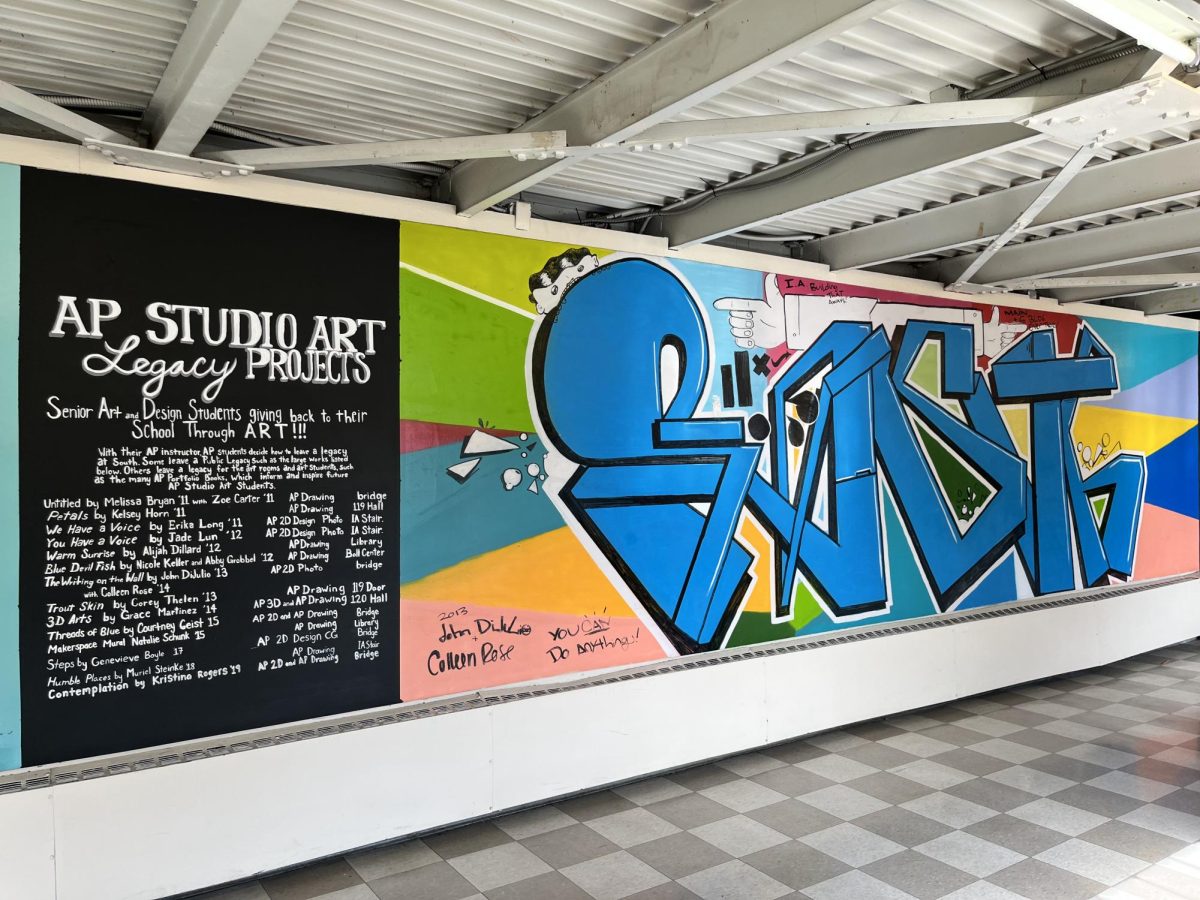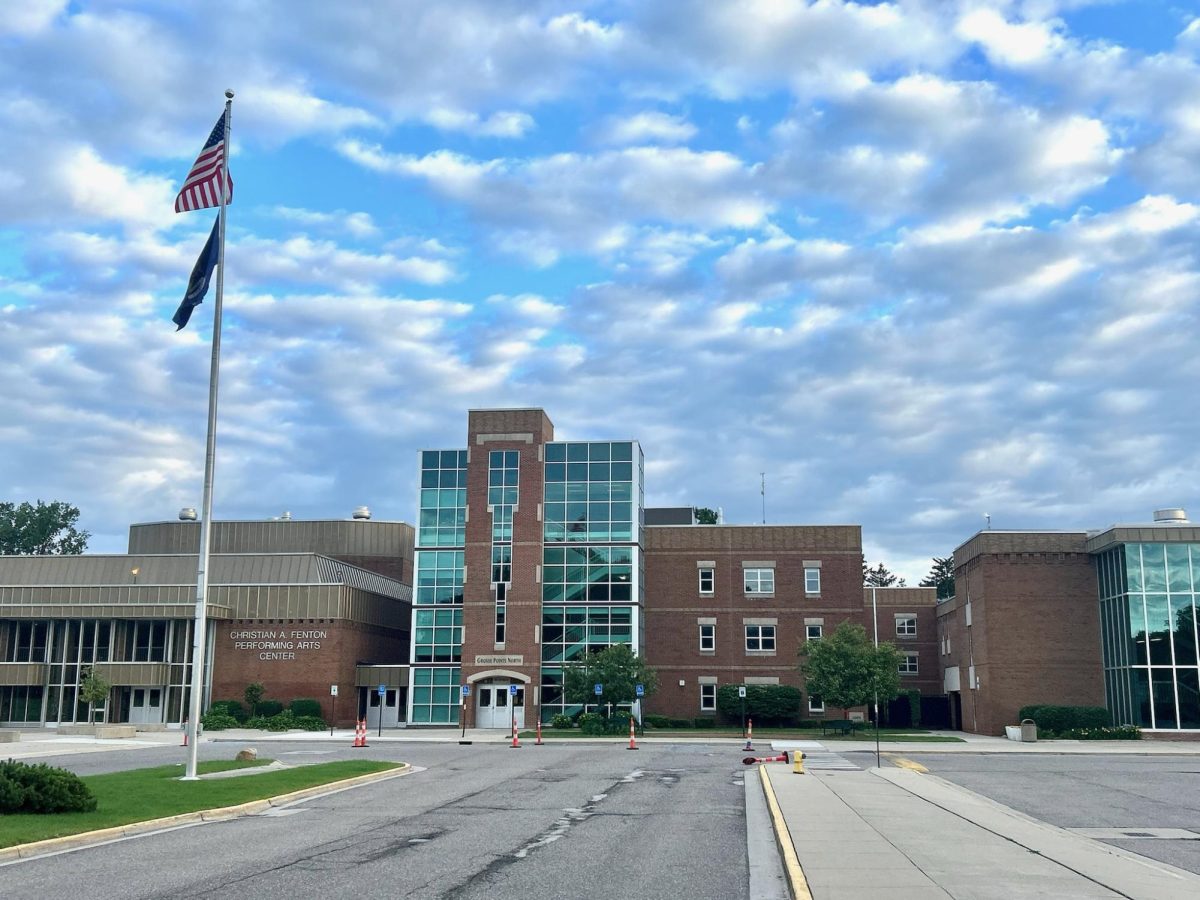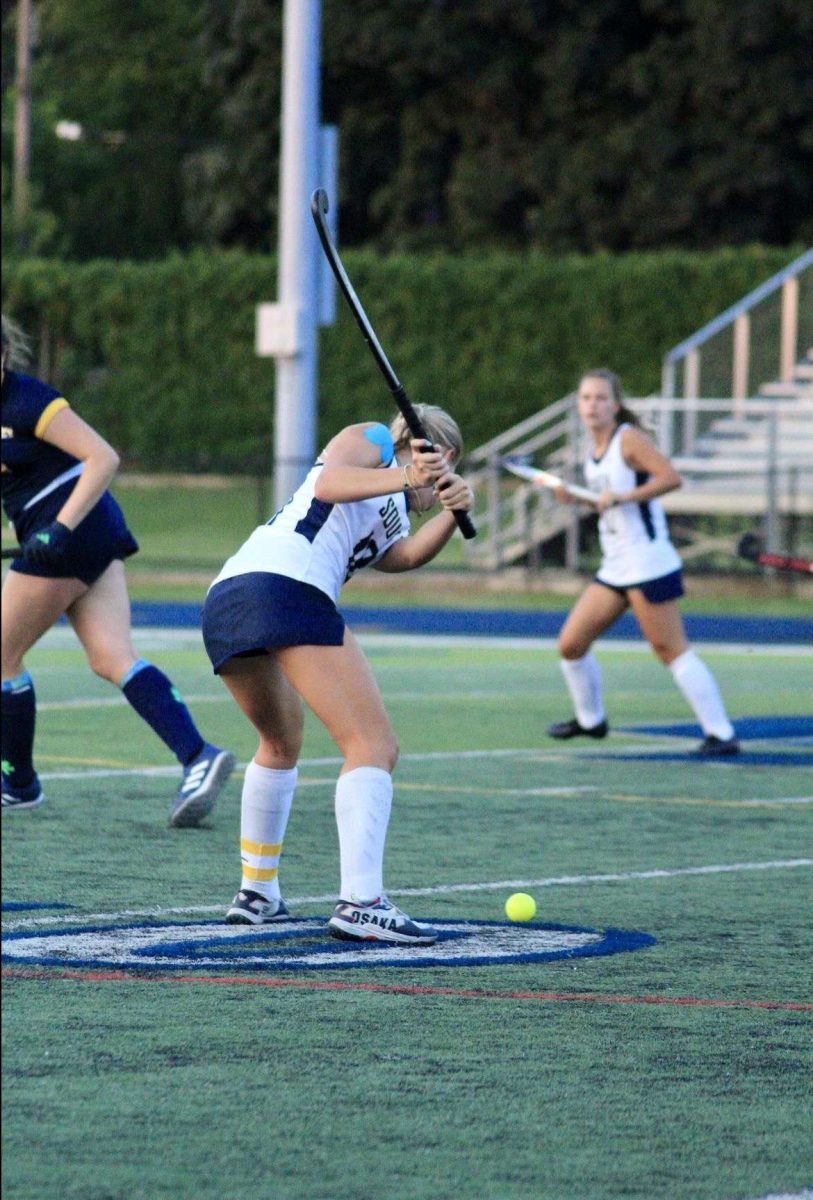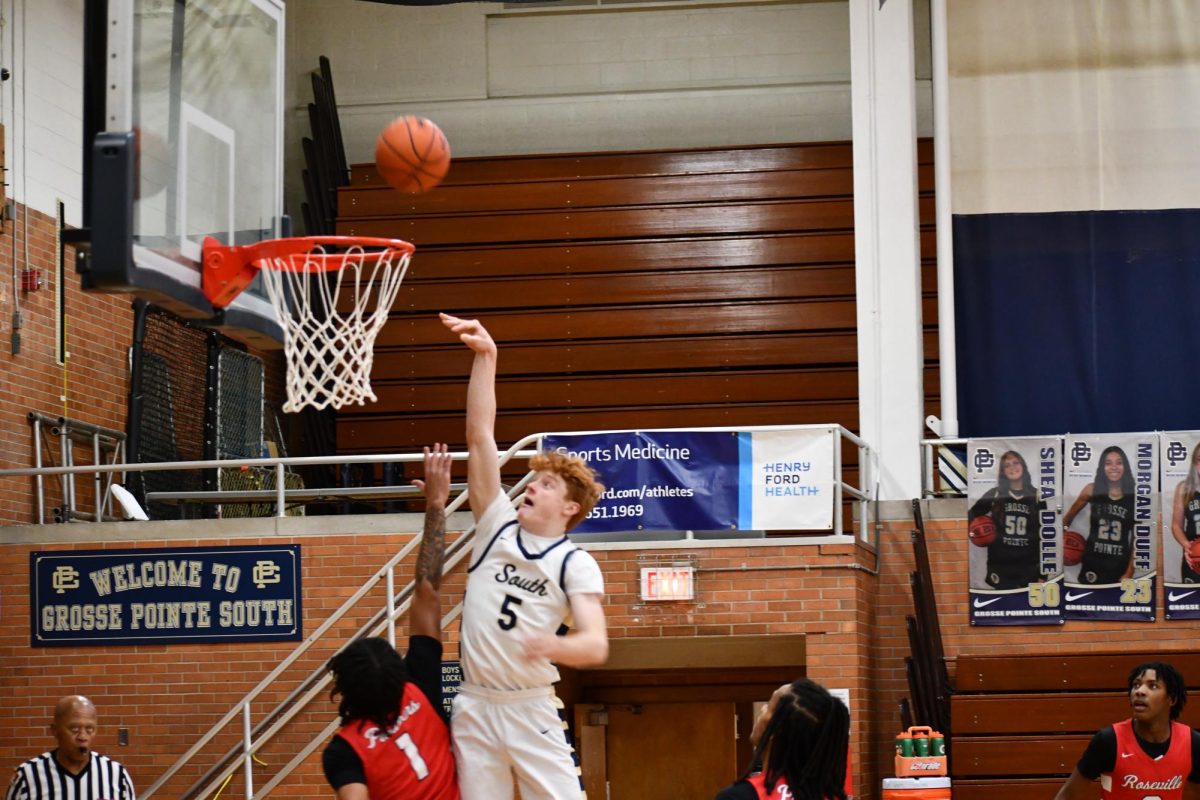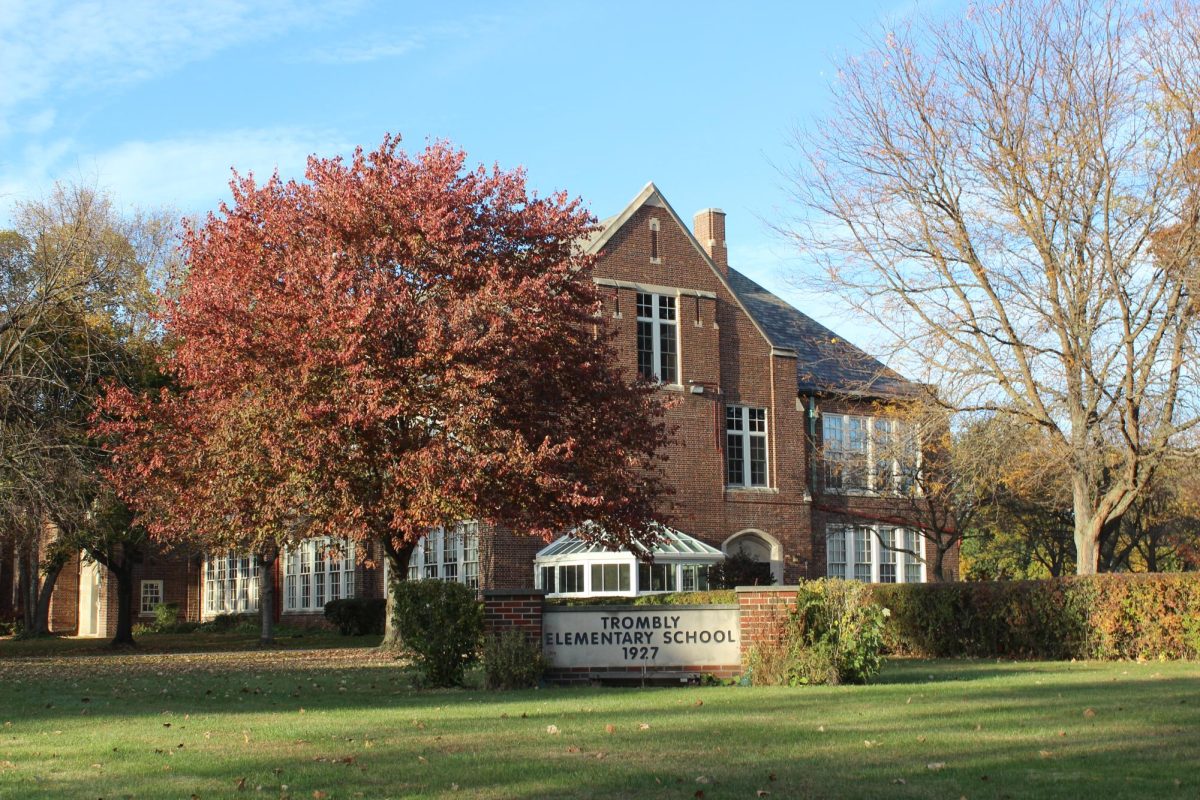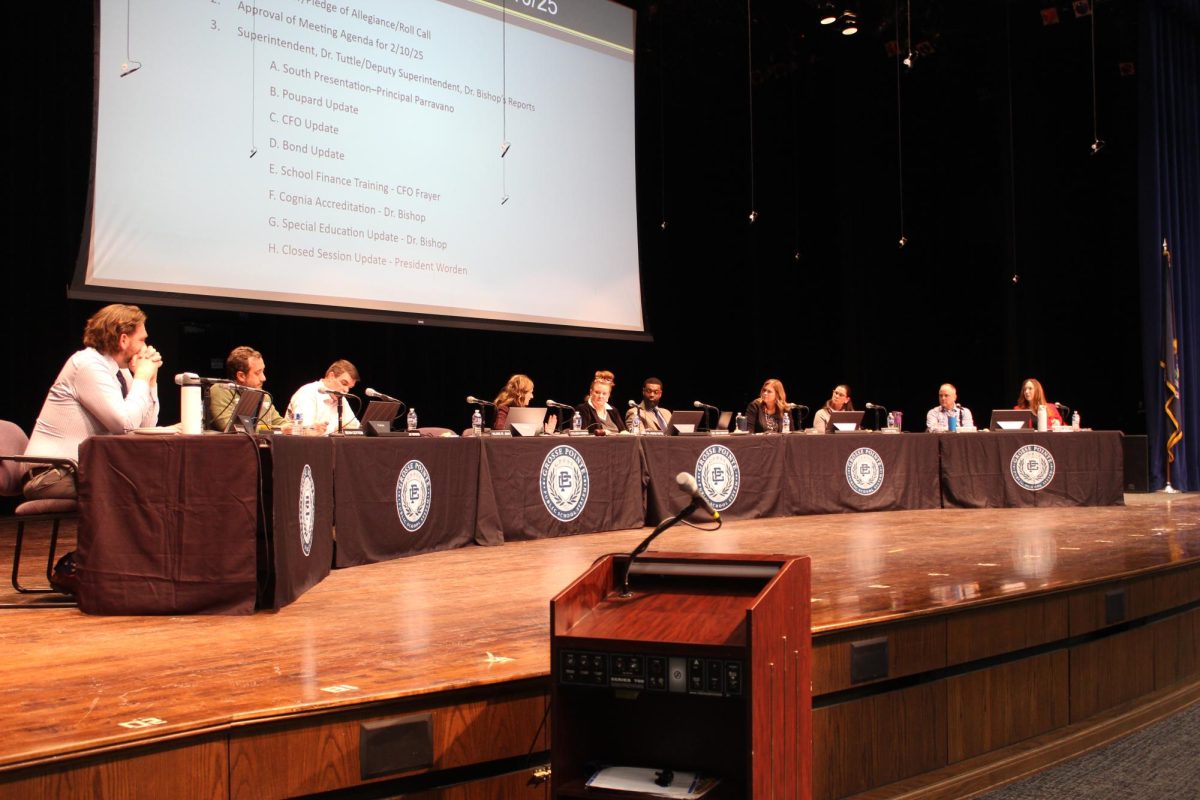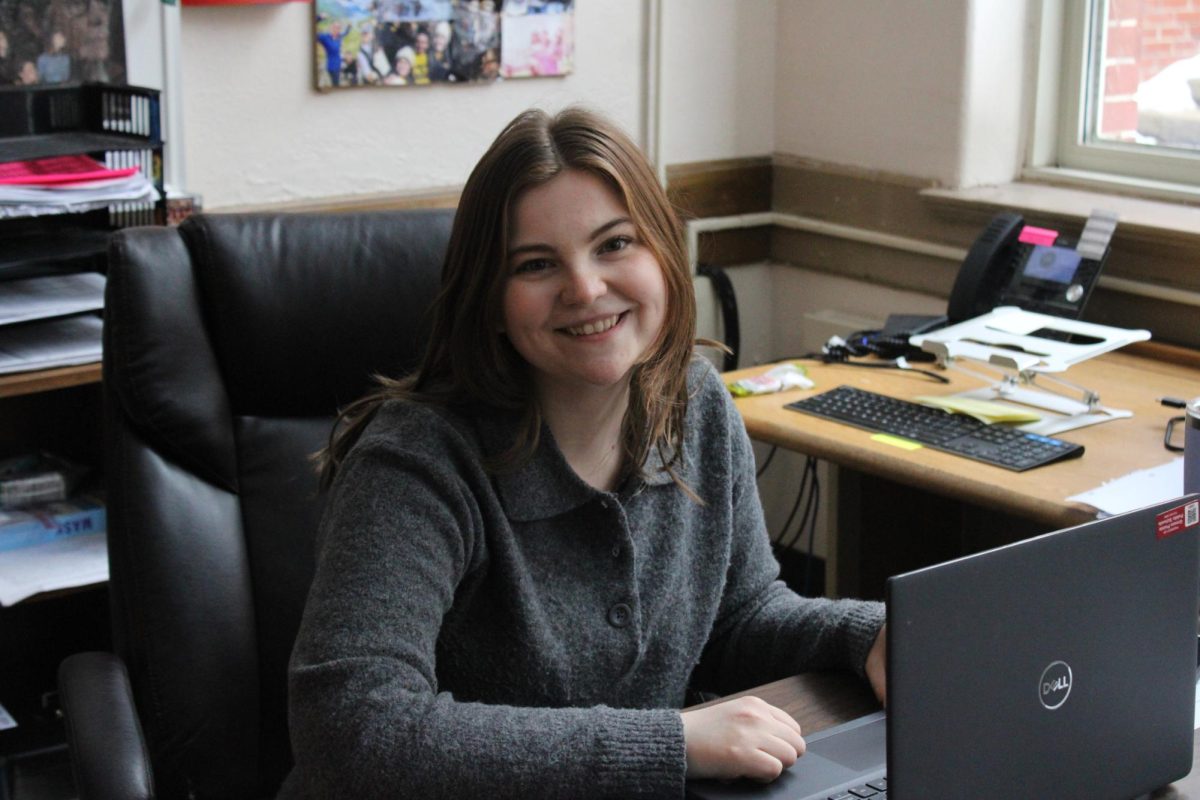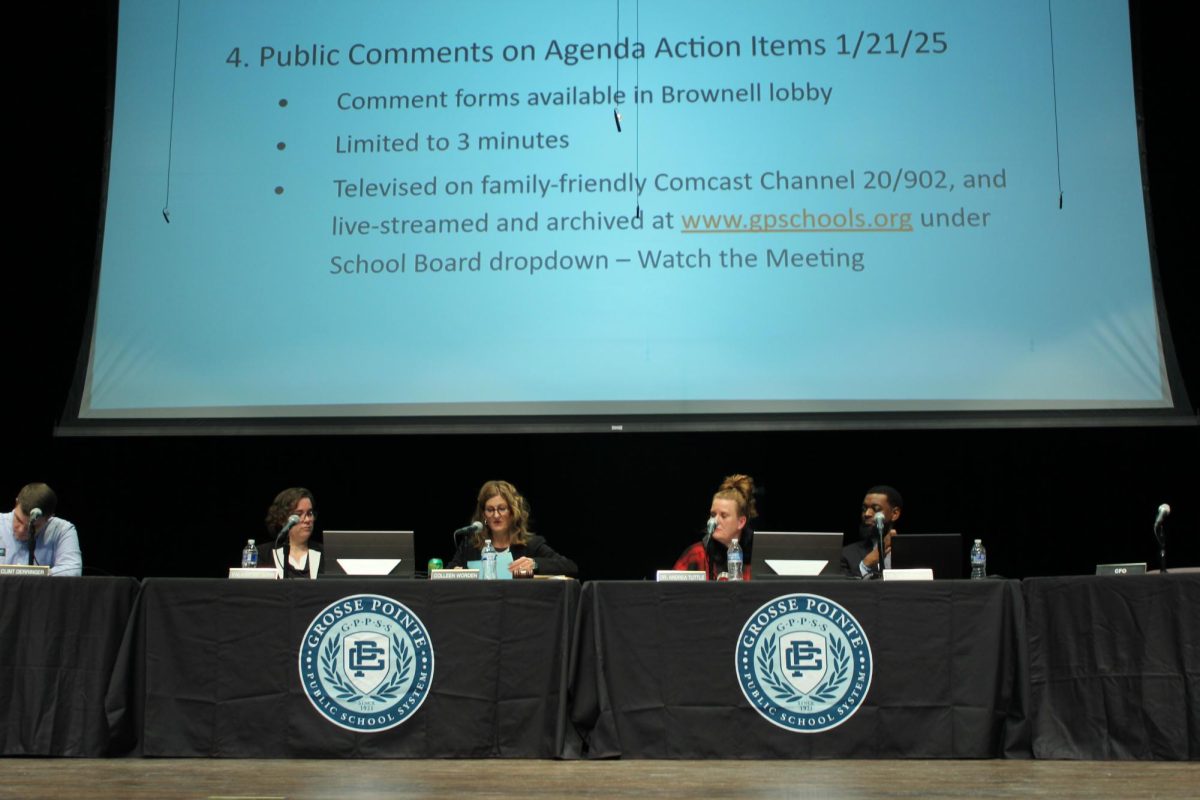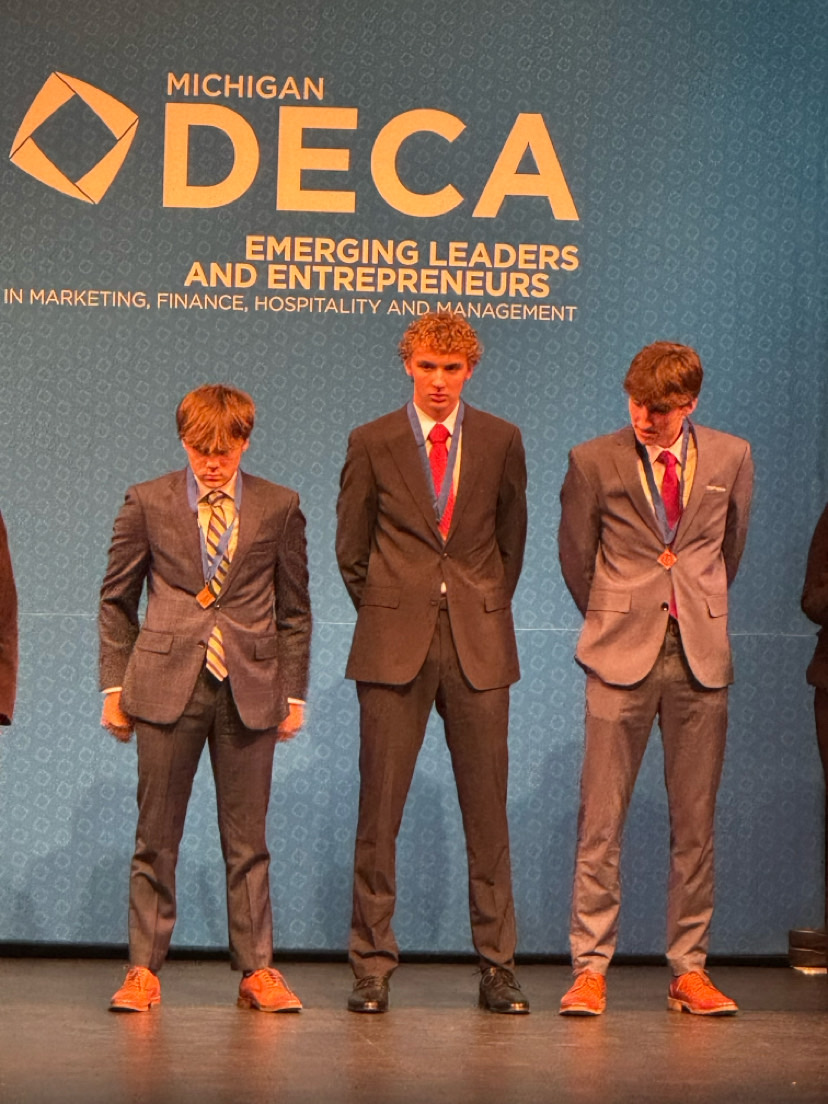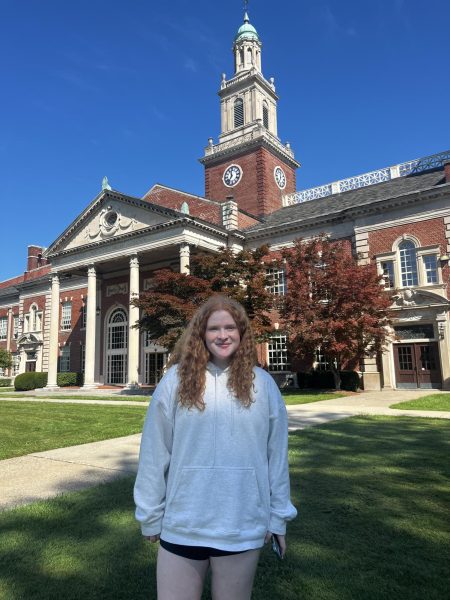As most community members know, GPPSS student enrollment has been on the decline. After over a decade of GPPSS dealing with declining enrollment, the projections of this year’s elementary student count increased slightly. The increase of a few students may not be enough to solve the district’s financial issues.
Currently, GPPSS operates seven elementary schools, three middle schools and two high schools to serve the approximately 50,800 people of all five Pointes and a portion of Harper Woods. In 2019, after months of consideration, the Board of Education voted to close Charles A. Poupard Elementary, located at the north end of the district, and Robert Trombly Elementary, located at the south end of the district. They also decided to move fifth graders to the middle schools. This decision was made in hopes of helping the district’s budget combat declining enrollment. Both schools had seen a significant decline in enrollment at the time of the vote.
In this analysis of the district we will explore enrollment trends, the national birth rate, the effect of closing schools, how high school curriculum is affected by dips in enrollment and possible solutions for declining enrollment.
Enrollment trends

Although enrollment is overall decreasing, there are good signs coming from the lower grades. According to the Plante Moran study for the 2024-25 school year, there will be about a 3% increase in enrollment for kindergarten and first grade district wide. Looking at enrollment data for young kids is historically an indication for future numbers.
Even with these promising numbers coming from the elementary schools, enrollment is projected to decrease throughout the whole district by over 100 kids. Just seven years ago GPPSS housed over 7,800 students. According to the Plante Moran study, GPPSS enrollment will be around 6,280 this year. That roughly equates more than a 14 million dollar loss from statewide funding since 2017. In 2017, South graduated 417 students, and this year is expected to graduate around 300.
A major factor in this is Grosse Pointe’s aging population and residents having fewer children. According to Plante Moran, the median household in Grosse Pointe holds 2.4 people. In an interview with School Board President, Sean Cotton, he discussed how these statistics impact the district.
“Right now in America, (Grosse Pointe) has the most 72-year-olds ever. We have an older than average population in Grosse Pointe. They will age out of their homes at some point. It is true that families are on average having fewer kids; however, families will move to the Pointes as a destination. We will always be that district if we maintain our schools. We need to keep all of our buildings open and operational. We do need to see enrollment increases to re-open Trombly. We must always invest in our buildings and in our academic offerings.”
Since 2021, the Board of Education has been forced to make tough budget cuts yearly to avoid closing buildings or cutting back on curriculum and instructional resources. The board’s efforts have been mostly successful by making these cuts; they were able to grow their fund equity balance. Some school board members argue that these cuts have not been enough, and more needs to be done concerning enrollment.
“The rightsizing that we did last year (2023-24 school year) is the start,” school board Vice President Ahmed Ismail said during the Oct. 8, 2024 school board meeting. “I do not think that we are done yet. It is very important that people understand that.”
Dynamic shifts
After several years of shrinking enrollment and budget cuts, this year’s financial situation may be improving. After the GPPSS reevaluated the 2023-24 budget, a savings of $1 million was realized after estimations were adjusted with actual costs.
Currently GPPSS taxes the community 1 mil for their Sinking Fund, a fund can be used for any building repairs, technology advancements, transportation and more. A mil is a tax unit, meaning for every 1000 dollars of taxable land, there is 1 dollar of tax. On this November’s ballot, GPPSS is asking for an increase to 3 mils for the next 10 years. This new revenue stream will also help the annual budget by providing a new funding source for items that were previously covered by the general fund.
In a post on a Meta Social Media platform on Nov. 1, 2024, Sean Cotton discussed the importance of the Sinking Fund Millage being passed.
“Another advantage of the Sinking Fund is its ability to relieve pressure on our General Fund,” Cotton wrote. “Essential expenses like technology and transportation can be covered by the Sinking Fund, allowing us to direct more General Fund dollars toward goals that directly impact our students, like maintaining competitive salaries for staff and reducing class sizes.”
Additionally to the Sinking Fund Millage Proposal, over the summer the state of Michigan changed what percent of a teacher’s pension they will be funding. On a yearly basis, the district will now receive 5.7% of the amount they pay to their teachers’ pensions returned. This equates to $5 to $6 million of an additional annual revenue.
If the Sinking Fund passes, and with the extra $1 million along with the new yearly money from the state, this will likely benifit their budget.
Nationwide crisis
This problem is not unique to GPPSS. Neighboring districts have had to combat declining enrollment, perhaps harsher than GPPSS has. This is largely due to the birth rate in Michigan declining 15-20% since 2010, according to the Center for Disease Control and Prevention (CDC).
One Indicator of this crisis is that large districts like Detroit Public Schools Community District have had to close over 200 buildings since 2000. At its population peak in the 1970s, Royal Oak Schools operated 18 elementary schools with two large high schools. Due to the declining enrollment, the district now operates 6 elementaries, one middle school, and one high school.
South principal, Moussa Hamka, has worked in education for over 20 years and has watched how enrollment impacts public schools.
“If you look nationally, we have issues with enrollment,” Hamka said. “With the birth rate declining across our country, and what we see is our American-born population is decreasing. The number of foreigners is increasing. The number of children per household also looks different across various demographics. This will change how public schools will operate”
According to the American Psychological Association, millennials are having less children due to economic factors. The national birth rate has been steadily decreasing since the 2008 recession.
“I think that is just a pattern we see playing out across America,” Hamka said. “The birth rate declined, we’re seeing a drop in enrollment, and it is a direct correlation to the financial crisis of 2008. From 2008 to 2012, the number of people who had kids was really low. Now you fast forward, you see how that has impacted Grosse Pointe South, but also schools across our state and our country.”
Specifically in Grosse Pointe, older residents whose kids have grown, tend to stay in their large homes, homes that could hold two, three or four kids. According to the Plante Moran study, the median age of Grosse Pointe residents is 57 years old, a stark contrast from the national median of 38 years old. Grosse Pointe lacks options for seniors to downsize creating few opportunities for young families to move into the community.
“We have a limited number of housing units in Grosse Pointe,” Hamka said. “It creates a supply and demand issue. You have an aging population. Many people love their houses, but people who are 80-years-old live in a three to 4,000 square foot house with five bedrooms. But there are limited options for senior housing in Grosse Pointe.”
Effects of Closing
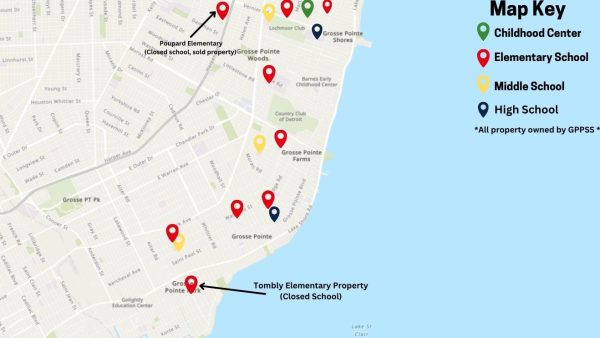
In 2019, when the board of education voted 5-2 to close Poupard Elementary and Trombly Elementary, the community did not go unheard. Hundreds sat in on school board meetings, ribbons were tied on trees around the community in support of not closing schools and parents vocalized their protest of the decision. Even though this was a decision made to better secure the district financially, the loss was felt deeply in the neighborhoods affected most.
Poupard was sold to Robertson Brothers Homes in 2023, who has partnered with Renovare Development to repurpose the property for housing, aiming to build 71 new housing units on the 6.5 acres of land.
During a school board meeting in June, Plante Moran representatives estimated that opening Trombly would cost the district between $5 to 10 million. Since the closure of Trombly and Poupard, some board members have been open to the possibility of opening Trombly backup, including board president Sean Cotton.
“Closing schools destroys a piece of the community,” Cotton said. “No one wants to see their school closed. Consolidating schools, it would put us, long term, in a worse position. If we are not a destination, walkable and bikeable school district, it will hurt us. These are reasons to move here with all the great offerings. A downward spiral of cutting (closing buildings), at the end of it you (GPPSS) won’t get that land back, you won’t get the schools back.”
Closing schools is something that is impactful- especially the younger the students. Mother Tina Kozak had two children who attended Trombly at the time of the vote, one in fifth grade and one in third grade- her family experienced the closing of Trombly firsthand.
“I loved the Trombly culture so much,” Kozak said. “It wasn’t so much the building or even the proximity to my house, it was truly the culture of Trombly that was so special. I didn’t know if being small and the fact that our neighbors all lived pretty close to us and our kids was what made the culture so special. It was just the culture that I was sad we wouldn’t be a part of anywhere else.”
When the decision to close the two elementary schools was made, the board of education voted to move the fifth grade to the middle schools. Today, the three middle schools house grades 5-8. At the time of this decision, community members were worried that this would be too difficult an environment for fifth graders to be in. Lucy Caulfield ’28 was the first group of fifth graders at Peirce to make the change.
“I think having us move to the middle school was a good experience, personally, because I got a feel for the school before I was fully a student there,” Caulfield said. “When you are in fifth grade at the middle school you just stay in one hallway, away from the older kids.”
A major concern for most parents was one that was a draw to the community: transportation to school. Before Trombly was closed, students did not need to cross any major streets to get to school. Since the change, students, once able to safely walk to school, now need to cross Jefferson, a street with a speed limit of 35 mph with only two available safe crossings.
Aubrey Crawford and her husband both attended GPPSS and now have children in the district: a sophomore at South, an eighth grader at Pierce and a third grader at Defer. Crawford’s oldest was part of the last 5th grade class at Trombly.
“Another family and our family cross our kids at Jefferson every morning because it is a busy road and they are only in third grade,” Crawford said. “There is a crossing guard at Westchester and Jefferson, but it is just too far. At Trombly I never worried about that one bit since we were so close to the school—less than a mile.”
Losing students to neighboring private schools was a concern when making the choice to close schools. Crawford and her husband both attended GPPSS and wanted to keep their children in public schools.
“We absolutely did not consider sending our kids to private schools,” Crawford said. “I am a huge proponent of public schools. I’m a product of the Grosse Pointe Public School System (GPPSS). My husband’s a product of GPPSS. When it (the closing of Trombly) happened, we were sad, but that did not cross my mind.”
To many, the decision to close Trombly and Poupard was a necessary one to make. The fear of putting the district in more financial trouble if it was not made was an idea that drove the vote.
“Anyone who had to make the decision knew it would be emotional,” Kozak said. “The schools and communities are emotional subjects. Those are really tough decisions to make, but I do think that we need to consider the big picture and be fiscally responsible with budgets and still keep in mind the goals for our schools and our community.”
Impact on High Schoolers
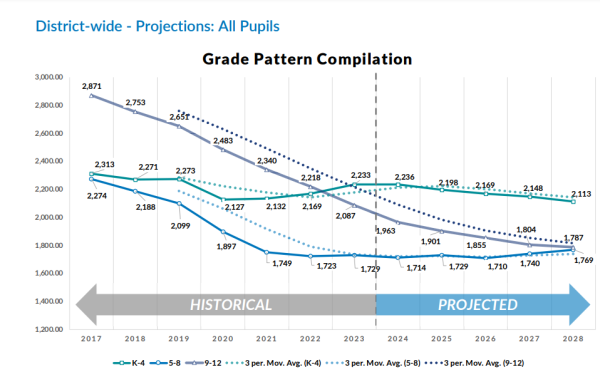
As enrollment has dropped at the secondary level, it is inevitable that it would be felt in many ways. South’s class of 2017 was 425 students, this year the school is expected to graduate 299 students. This loss is undoubtedly impacting student’s educational experiences.
A main attraction to Grosse Pointe Schools is the wide catalog of classes offered: Advanced Placement (AP), history, art, science and math. Less students signing up for classes makes it harder to have classes run. Hamka makes major decisions every year to decide what curriculum can run.
“Four or five years ago, I could find 30 kids to take any class. But now, as enrollment has started to dip, the number of kids who want to take the AP French, AP German and other higher classes is less, making it harder to let them run,” Hamka said. “Some classes are now, instead of running four or five times, only run twice. You lose some efficiency in that.”
Students have found themselves being turned down by teachers and counselors to take the classes they want, like Quin Grabowksi ’25. During Grabowski’s time at South she tried to take classes like Art History and Exploring Global Issues, and was turned down for both classes.
“When being told I felt upset and very disillusioned,” Grabowski said. “I think it’s an enrollment issue. There’s just not enough kids to justify running the class. We (GPPSS students) don’t go to a private school where, like, 15 kid classes are normal. If you don’t have a significant number of people in a class, it just won’t run and it is very frustrating.”
Currently, enrollment still allows for most AP classes to run, but this may not be the case if enrollment drops. During Hamka’s tenure at South, the peak enrollment was 1800 kids, over 700 more than today.
“We’re at a sweet spot right now where we can maintain what we have. We are big enough but small enough to be intimate,” Hamka said. “ I think it’s a good balance of where we’re at. Any smaller and we will start to lose our efficiencies. Then we will have to look at cutting curriculum.”
Dynamic shifts
After several years of shrinking enrollment and budget cuts, this year’s financial situation may be improving. After the GPPSS reevaluated the 2023-24 budget, a savings of $1 million was realized after estimations were adjusted with actual costs.
Currently GPPSS taxes the community 1 mil for their Sinking Fund, a fund can be used for any building repairs, technology advancements, transportation and more. With the increase to 3 mills the district hoping to have a new revenue stream to help the annual budget by providing a new funding source for items that were previously covered by the general fund.
Additionally to the Sinking Fund Millage Proposal, over the summer the state of Michigan changed what percent of a teacher’s pension they will be funding. On a yearly basis, the district will now receive 5.7% of the amount they pay to their teachers’ pensions returned. This equates to $5 to $6 million of an additional annual revenue.
Possible Solutions
With all of these numbers presented, it is an ongoing question for the district of what possibilities they have to combat their enrollment if there were budget concerns. Since 2019 when Trombly and Poupard were voted to be closed, solutions have floated around the community.
According to Niche, both Defer Elementary and Monteith Elementary have between 430-470 kids. This is a stark comparison to elementaries like Maire, Kirby and Richard that have under 290, with Maire having less than 240. For comparison, Trombly and Poupard were both closed when enrollment was around 300 students.
“We (GPPSS) do have some very small elementaries right now, but we have a couple elementaries bursting at the seams that are at max capacity,” Hamka said. “One solution, I know that’s been floated by the community, is could you reopen Trombly or look into redistricting. Changing what kids go to Kirby, which kids go to Monteith to try to relieve some of the pressure out of the congested schools into some of the schools that are not as populated could help. I think that is a solution to ensure that we’re maximizing our efficiency across all buildings.”
Grosse Pointe North has 921 kids, and South has less than 1,111 kids, according to current MiStar data. These numbers are down significantly since 10 years ago. In 2023, the Board of Education voted to close a wing of Grosse Pointe South, the IA building, due to there not being classes being run in the building and could not justify the cost of keeping the wing open.
One suggestion brought up by community members is the possibility of the fifth and sixth grade moving to the elementary schools, while seventh and eighth grades move to the high school buildings. With these suggestions, the seventh and eighth grade would be sectioned off from the rest of the school to limit interactions with older grades. Considering South currently has under 1,150 students and Pierce Middle School, as a whole according to Niche, has 529 students, it would not be possible to fit just the seventh and eighth grade into South. By doing this, GPPSS would save money by not having to fund the middle school buildings.
Another option that has been considered is closing a high school. The savings from not having to operate a huge building and consolidating staff would provide the district huge savings.
“One option that is certainly not very popular is to combine high schools, that would be difficult,” Hamka said. “Which beloved building do you close? I love South, but the people on the other end of town love North, so that would be a very emotional conversation. It would be a charged discussion in the community.”
To close a high school is an incredibly emotional conversation for a community to have. Although this seems like a harsh solution, Grosse Pointe could consider following in the steps of other districts that faced similar problems related to declining enrollment. It may seem a realistic option in upcoming years.
“The reality is both high schools can fit under one roof right now, either at North or at South. We can make it work,” Hamka said.
Wrap up
With the GPPSS budget coming in over one million over than expected, the possible Sinking Fund Millage passing and the additional state funding, it may not be necessary for GPPSS to make these decisions anytime soon. It is unpredictable where the GPPSS budget will be in ten years, or even two. There is no alarm sounding to close a building or cut mass amounts of resources. But with the mixture of national/local birth rates going down and the nature of Grosse Pointe residents being seniors, some solution may be necessary to keep the district financially sound.





